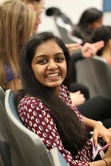|
By Niharika Vattikonda
The bold red lipstick that people all over admire dates back to ancient times – in Ancient Egypt, dye extracted from carmine beetles and ants became a cosmetic staple, with only the poorest classes not being able to procure the cosmetics. Cleopatra, for example, was often sighted and depicted with red-colored lips. Although the production and commercialization of lipstick have changed dramatically since then, one thing remains true: lipstick is a quintessential product, worn by over 80 percent of American women. Women use over 9 pounds of lipstick in their lifetimes, but over 30% of that is ingested, with greater amounts for flavored products.
One woman, however, wanted to create a lipstick that was both natural and safe to be ingested, as the continual use of lipstick products leads to ingestion of the product as well. Inspired by nothing more than simple kitchen chemistry, Susanne Langmuir created Toronto-based BITE Beauty, a boutique makeup line that specializes in lip products and its famous customized Lip Lab, in which customers can create their own lipsticks from unique food-grade ingredients, a variety of shades, and extra finishes and flavors. Before creating BITE Beauty, Susanne Langmuir worked in developing fragrances for Susanne Lang Fragrances, but after experience allergic reactions to synthetic components in cosmetics, she focused on developing high-performing, non-toxic lip products. Langmuir worked in sourcing natural ingredients for over a decade, working with international producers and cosmetic manufacturers. She believes that using natural ingredients sourced from free trade is “a real connection to the nutrient-rich benefits you get from things that are grown, harvested, and handpicked over functional synthetics.” Her lab is built around that principle of using only food-based ingredients, and as a result, her average production is about 2,000 per day, while production in a larger facility may exceed 40,000. Nevertheless, because they are so close to the process, there is increased flexibility to work with sensitive ingredients. Originally, BITE Beauty didn’t intend to start out as a lipstick manufacturer. BITE Beauty pitched strong ideas for lip cosmetics to private label manufacturers, but unfortunately, they received pushback because their microcrystalline wax and mineral oil were food-grade, whereas synthetic silicones received more praise because of their functional benefits. Because they stuck to their original idea, they hired chemists and built a lab in which the entire process was in their hands – temperature, for example, is controlled to maximize the nutritional benefit. Although they strive to be a local business, many of the ingredients used, including jojoba and shea butter are sourced internationally through fair trade. The process of creating your own lipstick in the Lip Lab, however, enables the customer to directly connect with the product. A consultation with a Lab Artist determines the mix of pigments needed to produce the ideal shade for the customer, and the customer can pick from four finishes, seven fragrances, and four optional shimmers to customize her lipstick even more. All the ingredients are placed in a blending cup and then melted down for about 30 seconds in a microwave. The blended mixture is then spun in a centrifuge about 1,200 times within the span of about 5 seconds. Finally, the lipstick is poured into molds with 12.7 mm diameter and placed on a -19˚C cooling table, so the lipstick is complete and ready to be packaged in about 5 minutes. As Langmuir said, “It’s a lot like cooking: There’s something about using your hands and doing things in a smaller way that creates something special.” 
About the Author
Niharika Vattikonda is currently a sophomore at Thomas Jefferson High School for Science and Technology in Northern Virginia – she loves biology and computer science. She recently completed a yearlong freshman research project on the effect of electromagnetic fields on E. coli. She first was exposed to Computer Science in middle school, when she learned coding in HTML/CSS, studied Java in freshman year, and is now learning app development on her own. Niharika enjoys STEM outreach, starting science clubs for girls at elementary schools and volunteering at science fairs and hackathons. When she’s not coding or writing for Scientista, Niharika enjoys debating, participating in Model United Nations, singing, and writing for her own blog, Teen Thoughts on Politics. Comments? Leave them below!
0 Comments
Your comment will be posted after it is approved.
Leave a Reply. |
LIFESTYLE BLOGRead our lifestyle advice, written exclusively for pre-professional women in science and engineering. From advice about fashion, work and family balance, self, wellness, and money, we've got you covered! |
The Scientista Foundation, Inc. All Rights Reserved © 2011-2021 | Based in NY | [email protected]
The Network for Pre-Professional Women in Science and Engineering
The Scientista Foundation is a registered 501(c)(3) -- Donate!
The Network for Pre-Professional Women in Science and Engineering
The Scientista Foundation is a registered 501(c)(3) -- Donate!
